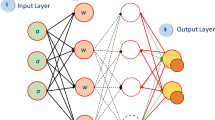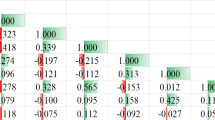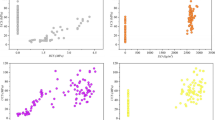Abstract
Unconfined Compressive Strength (UCS) is one of the most important mechanical properties in geomechanics and is crucial for reliable geo-mechanical modeling of geological formations. Traditional methods for determining UCS involve a great deal of laboratory testing on core samples, which can be very expensive, or collecting a large amount of data from well logs, which could be equally burdensome. Recently, with increasing demands on real-time, efficient UCS predictions in industries dealing with construction, mining, civil engineering, and even petroleum exploration, the need to realize innovative ways has grown. This paper, therefore, embarks on the introduction of a state-of-the-art machine learning framework that embeds the Multi-Layer Perceptron architecture with advanced meta-heuristic optimization techniques, namely Beluga Whale Optimization and Black Widow Optimization, to predict unconfined compressive strength with high accuracy. That is, unlike ANNs, which on occasions easily get bogged down in difficulties of parameter optimizations and slow convergence, it can enable fast and sure predictions, hence its eminently suitable use in real-time decision-making. Employing an extensive dataset compiled from previous scholarly studies, outstanding predictive performance was realized for this model. Therefore, the best-optimized model of MLBO2 was the superior predictor that gave a maximum \({R}^{2}\) of \(0.998\) and minimum RMSE of \(1.309\) in the test phase. These results confirm that the model is efficient in providing highly accurate UCS predictions with immense added advantages over the existing techniques and can contribute much to the geomechanical domains.












Similar content being viewed by others
Availability of data and materials
No datasets were generated or analysed during the current study.
References
Ulusay, R. (ed.): The ISRM Suggested Methods for Rock Characterization, Testing and Monitoring: 2007-2014. Springer International Publishing, Cham (2015). https://doi.org/10.1007/978-3-319-07713-0
Sahu, A., Sinha, S., Banka, H.: Fuzzy inference system using genetic algorithm and pattern search for predicting roof fall rate in underground coal mines. Int. J. Coal Sci. Technol. 11(1), 1 (2024)
Yagiz, S., Sezer, E.A., Gokceoglu, C.: Artificial neural networks and nonlinear regression techniques to assess the influence of slake durability cycles on the prediction of uniaxial compressive strength and modulus of elasticity for carbonate rocks. Int. J. Numer. Anal. Methods Geomech. 36(14), 1636–1650 (2012)
Song, Z., Wu, Y., Zhang, Y., Yang, Y., Yang, Z.: Mechanical responses and acoustic emission behaviors of coal under compressive differential cyclic loading (DCL): a numerical study via 3D heterogeneous particle model. Int. J. Coal Sci. Technol. 10(1), 31 (2023)
Zhang, C., Bai, Q., Han, P., Wang, L., Wang, X., Wang, F.: Strength weakening and its micromechanism in water–rock interaction, a short review in laboratory tests. Int. J. Coal Sci. Technol. 10(1), 10 (2023)
Niu, Q., Jiang, L., Li, C., Zhao, Y., Wang, Q., Yuan, A.: Application and prospects of 3D printing in physical experiments of rock mass mechanics and engineering: materials, methodologies and models. Int. J. Coal Sci. Technol. 10(1), 5 (2023)
Lu, Z., Ju, W., Gao, F., Du, T.: Numerical analysis on the factors affecting post-peak characteristics of coal under uniaxial compression. Int. J. Coal Sci. Technol. 11(1), 2 (2024)
Kahraman, S.: Evaluation of simple methods for assessing the uniaxial compressive strength of rock. Int. J. Rock Mech. Min. Sci. 38(7), 981–994 (2001)
Hack R, Huisman M.: Estimating the intact rock strength of a rock mass by simple means, 9th Congr. Int. Ass. Engin. Geol. Env, (2002)
Chang, C., Zoback, M.D., Khaksar, A.: Empirical relations between rock strength and physical properties in sedimentary rocks. J. Pet. Sci. Eng. 51(3–4), 223–237 (2006)
Ceryan, S., Tudes, S., Ceryan, N.: A new quantitative weathering classification for igneous rocks. Environ. Geol. 55, 1319–1336 (2008)
Çobanoğlu, İ, Çelik, S.B.: Estimation of uniaxial compressive strength from point load strength, Schmidt hardness and P-wave velocity. Bull. Eng. Geol. Environ. 67, 491–498 (2008)
Kahraman, S., Gunaydin, O., Alber, M., Fener, M.: Evaluating the strength and deformability properties of Misis fault breccia using artificial neural networks. Expert Syst. Appl. 36(3), 6874–6878 (2009)
Oyler, D.C., Mark, C., Molinda, G.M.: In situ estimation of roof rock strength using sonic logging. Int. J. Coal Geol. 83(4), 484–490 (2010)
Ulusay, R., Türeli, K., Ider, M.H.: Prediction of engineering properties of a selected litharenite sandstone from its petrographic characteristics using correlation and multivariate statistical techniques. Eng. Geol. 38(1–2), 135–157 (1994)
Altindag, R., Alyildiz, I.S., Onargan, T.: Mechanical property degradation of ignimbrite subjected to recurrent freeze–thaw cycles. Int. J. rock Mech. Min. Sci. 41(6), 1023–1028 (2004)
Kayabali, K., Selcuk, L.: Nail penetration test for determining the uniaxial compressive strength of rock. Int. J. Rock Mech. Min. Sci. 47(2), 265–271 (2010)
Yilmaz, I.: Use of the core strangle test for tensile strength estimation and rock mass classification. Int. J. Rock Mech. Min. Sci. 47(5), 845–850 (2010)
Gokceoglu, C.: A fuzzy triangular chart to predict the uniaxial compressive strength of the Ankara agglomerates from their petrographic composition. Eng. Geol. 66(1–2), 39–51 (2002)
Gokceoglu, C., Zorlu, K.: A fuzzy model to predict the uniaxial compressive strength and the modulus of elasticity of a problematic rock. Eng. Appl. Artif. Intell. 17(1), 61–72 (2004)
Sonmez, H., Tuncay, E., Gokceoglu, C.: Models to predict the uniaxial compressive strength and the modulus of elasticity for Ankara Agglomerate. Int. J. Rock Mech. Min. Sci. 41(5), 717–729 (2004)
Baykasoğlu, A., Güllü, H., Çanakçı, H., Özbakır, L.: Prediction of compressive and tensile strength of limestone via genetic programming. Expert Syst. Appl. 35(1–2), 111–123 (2008)
Akbarzadeh, M.R., Ghafourian, H., Anvari, A., Pourhanasa, R., Nehdi, M.L.: Estimating compressive strength of concrete using neural electromagnetic field optimization. Materials (Basel) 16(11), 4200 (2023)
Tejani, G.G., Sadaghat, B., Kumar, S.: Predict the maximum dry density of soil based on individual and hybrid methods of machine learning. Adv. Eng. Intell. Syst. 2(03), 98–109 (2023)
Kahraman, S., Alber, M.: Estimating unconfined compressive strength and elastic modulus of a fault breccia mixture of weak blocks and strong matrix. Int. J. rock Mech. Min. Sci. 43(8), 1277–1287 (2006)
Yilmaz, I., Yuksek, G.: Prediction of the strength and elasticity modulus of gypsum using multiple regression, ANN, and ANFIS models. Int. J. rock Mech. Min. Sci. 46(4), 803–810 (2009)
Sarkar, K., Tiwary, A., Singh, T.N.: Estimation of strength parameters of rock using artificial neural networks. Bull. Eng. Geol. Environ. 69, 599–606 (2010)
Çanakci, H., Pala, M.: Tensile strength of basalt from a neural network. Eng. Geol. 94(1–2), 10–18 (2007)
Gokceoglu, C., Zorlu, K., Ceryan, S., Nefeslioglu, H.A.: A comparative study on indirect determination of degree of weathering of granites from some physical and strength parameters by two soft computing techniques. Mater Charact 60(11), 1317–1327 (2009)
Yilmaz, I., Marschalko, M., Bednarik, M., Kaynar, O., Fojtova, L.: Neural computing models for prediction of permeability coefficient of coarse-grained soils. Neural Comput. Appl. 21, 957–968 (2012)
Zhang, Y., et al.: Research on coal-rock identification method and data augmentation algorithm of comprehensive working face based on FL-Segformer. Int. J. Coal Sci. Technol. 11(1), 48 (2024)
Meulenkamp, F., Grima, M.A.: Application of neural networks for the prediction of the unconfined compressive strength (UCS) from Equotip hardness. Int. J. rock Mech. Min. Sci. 36(1), 29–39 (1999)
Dehghan, S., Sattari, G., Aliabadi, M.A.: Prediction of uniaxial compressive strength and modulus of elasticity for Travertine samples using regression and artificial neural networks. Min. Sci. Technol. 20, 41–46 (2010). https://doi.org/10.1016/S1674-5264(09)60158-7
Mishra, D.A., Basu, A.: Estimation of uniaxial compressive strength of rock materials by index tests using regression analysis and fuzzy inference system. Eng. Geol. 160, 54–68 (2013)
Moayedi, H., Hayati, S.: Applicability of a CPT-based neural network solution in predicting load-settlement responses of bored pile. Int. J. Geomech. 18(6), 6018009 (2018)
Zhong, C., Li, G., Meng, Z.: Beluga whale optimization: A novel nature-inspired metaheuristic algorithm. Knowledge-Based Syst. 251, 109215 (2022). https://doi.org/10.1016/j.knosys.2022.109215
Hill, H., Dietrich, S., Yeater, D., McKinnon, M., Miller, M., Aibel, S., Dove, Al.: Developing a catalog of socio-sexual behaviors of beluga whales (Delphinapterus leucas) in the care of humans. Animal Behav. Cognit. 2(2), 105–123 (2015). https://doi.org/10.12966/abc.05.01.2015
Hayyolalam, V., Kazem, A.A.P.: Black widow optimization algorithm: a novel meta-heuristic approach for solving engineering optimization problems. Eng. Appl. Artif. Intell. 87, 103249 (2020)
Holland, J.: Adaptation in natural and artificial systems, univ. of mich. press. Ann Arbor 7, 390–401 (1975)
Narendra, B.S., Sivapullaiah, P.V., Suresh, S., Omkar, S.N.: Prediction of unconfined compressive strength of soft grounds using computational intelligence techniques: a comparative study. Comput. Geotech. 33(3), 196–208 (2006)
Ceryan, N., Okkan, U., Kesimal, A.: Prediction of unconfined compressive strength of carbonate rocks using artificial neural networks. Environ. Earth Sci. 68, 807–819 (2013)
Majdi, A., Rezaei, M.: Prediction of unconfined compressive strength of rock surrounding a roadway using artificial neural network. Neural Comput. Appl. 23, 381–389 (2013)
Rezaei, M., Majdi, A., Monjezi, M.: An intelligent approach to predict unconfined compressive strength of rock surrounding access tunnels in longwall coal mining. Neural Comput. Appl. 24, 233–241 (2014)
Mohamad, E.T., Armaghani, D.J., Momeni, E., Abad, S.V.A.N.K.: Prediction of the unconfined compressive strength of soft rocks: a PSO-based ANN approach. Bull. Eng. Geol. Environ. 74(3), 745–757 (2015). https://doi.org/10.1007/s10064-014-0638-0
Acknowledgements
I would like to take this opportunity to acknowledge that there are no individuals or organizations that require acknowledgment for their contributions to this work.
Funding
This work was supported by Chongqing Education Commission (Grant No. KJQN202104014 and No. KJQN202104011).
Author information
Authors and Affiliations
Contributions
TL: Writing-Original draft preparation. Conceptualization. Supervision. Project administration.
Corresponding author
Ethics declarations
Conflict of interest
The authors declare no competing interests.
Additional information
Publisher's Note
Springer Nature remains neutral with regard to jurisdictional claims in published maps and institutional affiliations.
Rights and permissions
Springer Nature or its licensor (e.g. a society or other partner) holds exclusive rights to this article under a publishing agreement with the author(s) or other rightsholder(s); author self-archiving of the accepted manuscript version of this article is solely governed by the terms of such publishing agreement and applicable law.
About this article
Cite this article
Li, T. Estimating unconfined compressive strength using a hybrid model of machine learning and metaheuristic algorithms. SIViP 19, 164 (2025). https://doi.org/10.1007/s11760-024-03667-3
Received:
Revised:
Accepted:
Published:
DOI: https://doi.org/10.1007/s11760-024-03667-3




